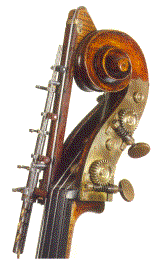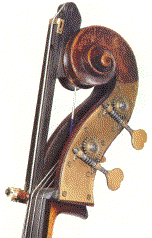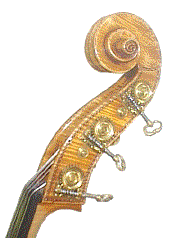| Welcome to Bill Bentgen's Website |
|
|
|
|
|
|
Double basses have existed in three, four, and five string configurations at different times and places. Paul Brun's new history of the bass deals with the matter extensively. (Brun, Paul, A New History of the Double Bass (Villeneuve d'Ascq, Paul Brun Productions, 2000)).
There was a 5 string double bass that was popular in Vienna during what Brun calls "The Golden Age of Virtuosity". this period existed from about 1760 until about 1830. These instruments were usually tuned as follows:

The first mention of a 5 string orchestral double bass was in the Leipzig Gewandhaus Orchestra in 1880. Hans von Bülow used 5 string basses in a cycle of the Beethoven symphonies. In 1882, a 5 string bass was being used by Willy Krausse, principal double bass of the Berlin Philharmonic Orchestra.
Today, both C extensions and a fifth string are used to obtain notes lower than the open E string. There are two types of extension, mechanical and fingered. In the United States, C extensions are prevalent, although Joseph Guastafeste, principal of the Chicago Symphony uses a 5 string bass. (For more about extensions, visit Jonas Lohse's excellant website.) German orchestras use 5 string basses, and all three major London orchestras use 5 string basses.
 |
 |
 |
| Mechanical Extension | Fingered Extension | 5 String |
I find the 5 string bass has the following advantages over a C extension:
It is easier to finger the notes with the left hand. In fast passages, it takes much longer to reach back on an extension then it does to reach over to the 5th string.
It avoids intonation problems caused by releasing and re-closing the E clamp.
On 5 string basses, the low string is tuned to either C or B. I tune mine to B as follows:

This has the following advantages:
It keeps all strings tuned in intervals of fourths, allowing easier tuning with harmonics.
It keeps fingering patterns the same for intervals and scales. A low C major scale fingers exactly the same as an F major scale, or Bb major scale.
It makes the low B available for the 2 or 3 pieces in the symphonic literature that call for it.
It makes people with C extensions green with envy, although the Heartlands String Bass Shop in Iowa City, Iowa offers a B extension.
|
|
|
|
|
|
 |
Please send any comments about these pages to
|
|